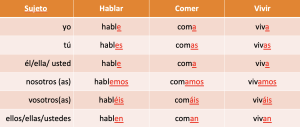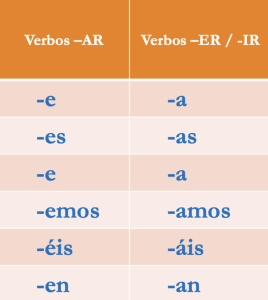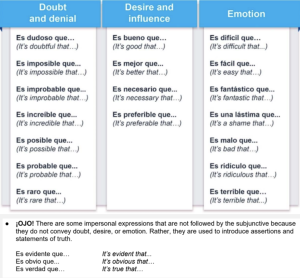2 Opiniones sobre el arte
opiniones sobre el arte
This lesson is designed to introduce students to the Spanish present subjunctive grammatical form, through a lesson centered around art. Students will begin by distinguishing the differences between the indicative and subjunctive forms and discuss the circumstances and situations that require the use of the subjunctive. This lesson will cover present subjunctive conjugations and various impersonal expressions that are used to express doubt, desire, and emotion. The activities presented in this lesson will give students the opportunity to differentiate the different uses of indicative and subjunctive forms and also utilize the subjunctive to express emotions and opinions about street art.
Linguistic Level
Students participating in this lesson should have the linguistic level of Spanish Novice-High to Intermediate-Low in accordance with ACTFL proficiency guidelines. Activities are suitable for 3rd semester Spanish students at the university level or 3rd year Spanish students at the high school level.
Modality
This lesson is designed for an online asynchronous classroom modality.
Lesson Objectives
- Differentiate when to use the present subjunctive and present indicative grammar forms
- Employ present subjunctive conjugations
- Identify impersonal expressions and how they are used to express doubt, desire, and emotion
- Express opinions on different forms of street art
los modos verbales (Lesson content 1.0)
En español hay 2 modos verbales:
- Indicativo
- Se usa el indicativo para expresar:
- Hechos
- Cosas que estás seguro que han ocurrido o sucederán
- Expresa seguridad
- Se usa el indicativo para expresar:
- Subjuntivo
- Se usa el subjuntivo para expresar:
- Deseos
- Opiniones
- Dudas
- Recomendaciones
- Reacciones impersonales
- Expresa inseguridad
- Se usa el subjuntivo para expresar:
Las conjugaciones del subjuntivo

¡Ojo! Las conjugaciones del subjuntivo son diferentes al indicativo. Mira la diferencia a continuación entre los verbos de AR/ER/IR.

Las conjugaciones del subjuntivo son el opuesto de las conjugaciones del indicativo. Los verbos AR usan los términos de ER/IR y los verbos ER/IR usan los términos de AR.
¡A conjugar el subjuntivo!
En esta actividad, empareja la conjugación del subjuntivo con el verbo y sujeto apropiado.
Expresiones impersonales (Lesson content 2.0)
En español tenemos varias expresiones que requieren el uso del subjuntivo porque expresan dudas, deseos, recomendaciones y emoción. Estas expresiones se llaman “expresiones impersonales”. ¡Ojo! Hay algunas expresiones impersonales que no llevan el subjuntivo porque no expresan dudas, deseos, recomendaciones o emoción.
Mira la siguiente tabla de las expresiones impersonales:

Presta atención a las expresiones que utilizas para que puedas elegir el modo apropiado, el indicativo o el subjuntivo.
¿Indicativo o subjuntivo?
Lee las siguientes oraciones de la actividad y decide si cada una utiliza en indicativo o el subjuntivo.
Opiniones sobre el arte (Lesson content 3.0)
Ahora vamos a utilizar la información que aprendimos sobre el indicativo y el subjuntivo para crear opiniones y reacciones sobre el arte. Mira el siguiente video sobre el distrito del grafiti en Colombia.
Durante el video, completa las cuatro (4) actividades interactivas.
Reflection Questions
To end this lesson, students will reflect on the information and content they learned and utilized in the previous activites. For Novice and Intermediate language learners, the subjunctive can be a very complex, confusing new grammar structure to grasp. The following questions will allow students to reflect on the content presented, identify the what they feel they successfully learned, and also recognize areas of improvement.
Ask students to respond to the following questions in the target language:
- ¿Crees que puedes identificar la diferencia entre el subjuntivo y el indicativo?
- ¿Qué sabes ahora que no sabías antes sobre el subjuntivo?
- ¿Hay algo que no entiendes? ¿Qué te gustaría mejorar en el futuro?
- ¿Te gusta el graffiti y el arte urbano que viste en el video? ¿Por que?
Tips and Instructions for Instructors using this Resource
This lesson is derived from a Spanish-300 Intermediate level unit about street art and social justice. This activity can be adapted to fit a variety of unit and lesson themes/topics. Students completing this activity are also being introduced to the subjunctive. The expectation is that students begin to identify the subjunctive and also differentiate the differences between the indicative and subjunctive moods in Spanish. The H5P activities provided in this lesson are designed to act as low-stakes, formative assessments that give students opportunities to take risks and engage with the language. When students have the freedom to take risks, they develop deeper problem-solving skills and comprehension. These activities can be assessed by participation and engagement with the materials.
Makenzie Heffernon M.A.
Bio: I received my Master’s Degree in Second Language Acquisition in 2024 from Kansas State University while serving as an instructor of undergraduate Spanish courses (Spanish-101 & Spanish-300). Previously, I received my B.A. in Spanish and a minor in Anthropology from Kansas State University in 2022 while serving as a Teaching Assistant of Cultural Anthropology. I received a certificate in Global Virtual Collaboration from X-Culture and earned a certificate in International Business from Kansas State University in 2023. My academic interests include second language acquisition, bilingualism, linguistic identities, sociolinguistics, study abroad, cross-cultural analytics, and international relations. I currently serve as a High School Spanish Teacher in Chicago, IL teaching Spanish-300 and AP Spanish 5 courses.
Languages: Spanish/English
Lesson creation year: April, 2024


